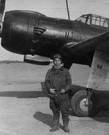|
|
||||
|
|
by Donald Levit  In times of child, man and woman suicide bombers in the At a questioned parallel between 9/11 and the Imperial Navy’s last-ditch desperation attacks at That emotional meeting coincided with the 23-city release in Conventionally done with archival material interspersed with interviews and one anime sequence, the film early centers on Morimoto -- she mostly disappears in the middle before reappearing -- who several years ago found that her twenty-year-deceased maternal uncle had trained as a kamikaze pilot whom the surrender had spared the fatal mission. Like all the surviving suicide pilots she and Hoaglund were to interview on the journey of discovery and eventual revisionist correction, the uncle had not talked to his family about his participation. “I didn’t tell my wife,” says another, “(we married after the war) or kids; it was ineffective, nothing to boast of, so we clammed up.” Neither remaining relatives of that generation nor contemporary cousins could tell her much -- she honors that uncle’s grave near the ending -- so she set out to see a kamikaze museum, delve into records, and contact still living pilots who talk of the experience for her camera, most often for the first time in any depth. In myth as often as fact, imminent defeat inspires selflessness, from Horatius at the bridge to Emperor Claudius’ gladiators, from Nathan Hale to St. Exupéry’s seven remaining Group 2-33 flight crews: “’I hope you don’t mean, Captain, that you expect to come out alive?’” “Kamikaze” means “Divine Wind,” in reference to the thirteenth-century typhoon that shattered Kublai Khan’s invasion fleet; the Japanese refer to them equally as “tokkotai,” meaning the “group of special attackers.” By whatever handle, they are heroes in their homeland, however publicly misunderstood and, according to the interviewees, officially misprized; on this side of the ocean they are incomprehensible fanatics, hopped-up death- and honor-obsessed maniacs. This latter, too, was the stereotype held by Morimoto despite close-knit family ties and studies in Not the main, but a starting, point is brief exposition of Tokyo’s embarkation on creating a Southeast Asia Co-Prosperity Sphere through control of the western Pacific rim for racial pride and the raw materials lacking on the industrializing home islands. At somewhat greater length, the film moves through military and civilian buildup, heavy national propaganda; the attack on Pearl Harbor and, with maps and voiced newsreels, to 1944-45 when, the Imperial fleet decimated, the homeland firebombed and the U.S. island-hopping ever-closer to unthinkable invasion, all pilots and inexperienced cadets were drafted as kamikazes in April 1945 and soon “Every Citizen a Kamikaze,” too, the Homeland Defense Organization facilitating sharpened bamboo poles with which women were to spear enemy troops. The four principal interviewees describe their groups’ wide unwillingness, and the inadequate flight training prepped by propaganda and brutal physical treatment and sake, and the peer pressure to appear brave and patriotic. Wishing the emperor would surrender and thus end national misery and personal fear of death, flying antiquated barely operational craft with pine resin substituted for oil and bamboo tanks coated with rice mash and containing only enough fuel for the outward journey, they were dazed heroes without a choice. They were awed by America’s industrial productivity, “just so huge B-29s,” democratic adaptability that devised defenses to shoot down nine of ten 800-pound-bomb suicide planes before they could even penetrate the fleet’s perimeter ring, and by its films -- they wanted an original-language Gone With the Wind print before taking off. Given inexperience and faulty equipment, many crashed almost immediately, sometimes surviving to be sent out yet again to die. Displeased with recent neologism “Islamic kamikazes,” these survivors among four thousand of their fellows “so talented and so alive” who died to sink forty ships, are today dedicated to peace and to honoring the memory of those who perished at Hiroshima or Tokyo-Osaka-Kobe or in Pacific waters. “Unless we abolish war, I believe the planet is doomed.” (Released by Edgewood Studios; not rated by MPAA.) |
||
|
© 2025 - ReelTalk Movie Reviews Website designed by Dot Pitch Studios, LLC |



